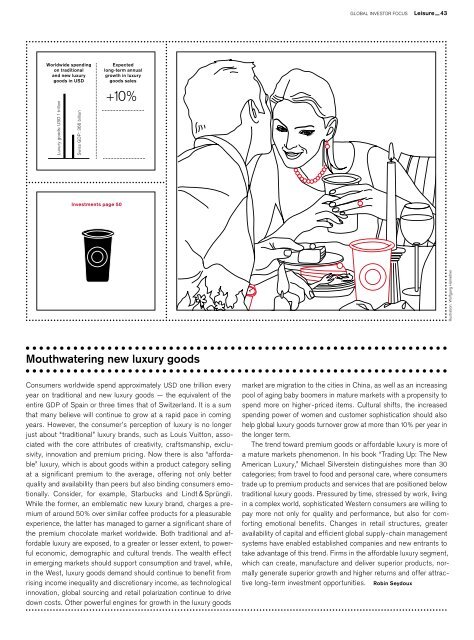Leisure
Global Investor, 01/2007 Credit Suisse
Global Investor, 01/2007
Credit Suisse
Create successful ePaper yourself
Turn your PDF publications into a flip-book with our unique Google optimized e-Paper software.
GLOBAL INVESTOR FOCUS <strong>Leisure</strong> — 43<br />
Worldwide spending<br />
on traditional<br />
and new luxury<br />
goods in USD<br />
Luxury goods: USD 1 trillion<br />
Swiss GDP: 366 billion<br />
Expected<br />
long-term annual<br />
growth in luxury<br />
goods sales<br />
+10%<br />
Investments page 50<br />
Illustration: Wolfgang Hametner<br />
Mouthwatering new luxury goods<br />
Consumers worldwide spend approximately USD one trillion every<br />
year on traditional and new luxury goods — the equivalent of the<br />
entire GDP of Spain or three times that of Switzerland. It is a sum<br />
that many believe will continue to grow at a rapid pace in coming<br />
years. However, the consumer’s perception of luxury is no longer<br />
just about “traditional” luxury brands, such as Louis Vuitton, associated<br />
with the core attributes of creativity, craftsmanship, exclusivity,<br />
innovation and premium pricing. Now there is also “affordable”<br />
luxury, which is about goods within a product category selling<br />
at a significant premium to the average, offering not only better<br />
quality and availability than peers but also binding consumers emotionally.<br />
Consider, for example, Starbucks and Lindt & Sprüngli.<br />
While the former, an emblematic new luxury brand, charges a premium<br />
of around 50% over similar coffee products for a pleasurable<br />
experience, the latter has managed to garner a significant share of<br />
the premium chocolate market worldwide. Both traditional and affordable<br />
luxury are exposed, to a greater or lesser extent, to powerful<br />
economic, demographic and cultural trends. The wealth effect<br />
in emerging markets should support consumption and travel, while,<br />
in the West, luxury goods demand should continue to benefit from<br />
rising income inequality and discretionary income, as technological<br />
innovation, global sourcing and retail polarization continue to drive<br />
down costs. Other powerful engines for growth in the luxury goods<br />
market are migration to the cities in China, as well as an increasing<br />
pool of aging baby boomers in mature markets with a propensity to<br />
spend more on higher-priced items. Cultural shifts, the increased<br />
spending power of women and customer sophistication should also<br />
help global luxury goods turnover grow at more than 10% per year in<br />
the longer term.<br />
The trend toward premium goods or affordable luxury is more of<br />
a mature markets phenomenon. In his book “Trading Up: The New<br />
American Luxury,” Michael Silverstein distinguishes more than 30<br />
categories; from travel to food and personal care, where consumers<br />
trade up to premium products and services that are positioned below<br />
traditional luxury goods. Pressured by time, stressed by work, living<br />
in a complex world, sophisticated Western consumers are willing to<br />
pay more not only for quality and performance, but also for comforting<br />
emotional benefits. Changes in retail structures, greater<br />
availability of capital and efficient global supply-chain management<br />
systems have enabled established companies and new entrants to<br />
take advantage of this trend. Firms in the affordable luxury segment,<br />
which can create, manufacture and deliver superior products, normally<br />
generate superior growth and higher returns and offer attractive<br />
long-term investment opportunities. Robin Seydoux

















